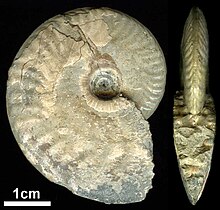
Réaumur is the remains of a lunar impact crater located on the southern edge of Sinus Medii. Its diameter is 51 km. It was named after the 18th century French scientist René de Réaumur. It shares an eroded rim with the similar crater Oppolzer to the northwest. It lies to the northwest of the large walled plain Hipparchus, and east of Flammarion. To the south is Gyldén, and farther to the south-southwest is Ptolemaeus.

Cleopatra, initially called Cleopatra Patera, is an impact crater on Venus, in Maxwell Montes.
Alcidellus is an oxyconic haploceratacean ammonite from the Middle Jurassic.

Aulacostephanus is an extinct ammonoid cephalopod genus from the Upper Jurassic Tithonian belonging to the perisphinctacean family Aulacostephanidae.
Asthenoceras is a genus of ammonoid from the Middle Jurassic with dwarfish, evolute, smooth, compressed, discoidal, strongly keeled shell. Asthenoceras belongs to the Sonniniidae and may be a subgenus of the Lower Jurassic Grammoceras.

Arcticoceras is an extinct ammonoid cephalopod genus from the late Middle Jurassic belonging to the ammonite family Cardioceratidae, more commonly found to high northern latitudes.
Balticeras is an involute, discoidal Upper Jurassic (Oxfordian) ammonite found in England, Germany, and Switzerland, belonging to the Perisphinctidae. The shell is strongly embracing, tending to be oxyconic. Sides are gently curved, converging on a narrow to sharp ventral rim.
Docidoceras is an extinct ammonite genus from the order Ammonitida that lived during the Middle Jurassic. Docidoceras is included in the family Otoitidae which makes up part of the ammonite superfamily Stephanoceratoidea.
Benacoceras is a strongly ribbed, evolute ammonite from the Late Jurassic, coiled so that all whorls are exposed. Ribbing is biplicate, with very short secondaries. The venter, the outer rim, is smooth, at least on the outer whorl.
Glochiceras is a haploceratid ammonite characterized by a small, smooth, compressed, evolute shells with large lappets and a median lateral groove. Its geographic distribution is fairly cosmopolitan, but it is limited stratigraphically to the Oxfordian and Kimmeridgian stages in the Upper Jurassic.
Bifericeras is a Lower Jurassic ammonite belonging to the family Eoderoceratidae, and sometimes placed in the subfamily Xipherceratinae. Whorls are strongly depressed, but still evolute in coiling. The early growth state is prolonged, and smooth, followed by a late growth stage with rounded, straight, bituberculate ribs.

Cadomites is an extinct ammonite genus from the superfamily Stephanoceratoidea that lived during the Middle Jurassic.
Dorsetensia is a narrowly coiled discoidal ammonite from the early Middle Jurassic, lower Bajocian, belonging to the family Sonniniidae of the superfamily Hildoceratoidea. The inner whorls are ribbed or smooth, outer whorl is smooth. The outer rim (venter) is narrow, with a keel running along the middle. The umbilicus, the opening in the middle of the shell exposing inner whorls, is of moderate size with a sharp, sometimes undercut edge.

Oppelia is a haploceratoid ammonite and type genus for the Oppeliidae that lived during the Middle Jurassic. Shells of Oppelia are involute with a small to moderate size umbilicus, bluntly rounded to sharp venter, and deeply impressed dorsum. Sides are generally smooth but may be variously ribbed on the outer flanks. Similar and related genera include Oxycerites and Oecotraustes.
Oecotraustes is an extinct cephalopod genus included in the ammonid family Oppeliidae and named by Waagen in 1869. The genus lived during the Middle Jurassic.
Lissoceras is an involute, smooth or finely vetrolaterally ribbed, ammonite with a blunt, un-keeled venter, included in the Haploceratidae, that lived from the Lower Bajocian - Middle Oxfordian in what is now Europe, south Asia, and southern Alaska.
Hebetoxyites is a genus of ammonoid cephalopod from the middle part of the Bajocian stage, middle Jurassic, included in the Strigoceratidae, Haplocerataceae. The shell is oxyconic, with a sharp rim but no keel, and involute, with the inner whorls hidden. The umbilicus is very small. Sides have a spiral ridge but are not striate.
Ochetoceras is a genus of ammonites, belonging to the Oppeliidae, that lived during the Late Jurassic from the early Oxfordian to the early Tithonian, and type for the subfamily Ochetoceratinae.
Production of the 2015 film Jurassic World was stalled for years in development hell while the film's storyline underwent numerous revisions. Development of the film, known then as Jurassic Park IV, began in 2001. William Monahan was announced as screenwriter in 2002, and the film was scheduled for a 2005 release. When Monahan left to work on another project, he was replaced in 2004 by John Sayles. By 2005, the start of production had stalled, as executive producer Steven Spielberg was not satisfied with any of the script drafts. In 2006, Jurassic Park III director Joe Johnston was set to direct the film, which was subsequently expected for release in 2008. By 2010, filming had yet to begin. Johnston and Spielberg intended to work on the film following the completion of their own respective film projects. Writer Mark Protosevich was hired in 2011, although two story treatments by him were rejected.






